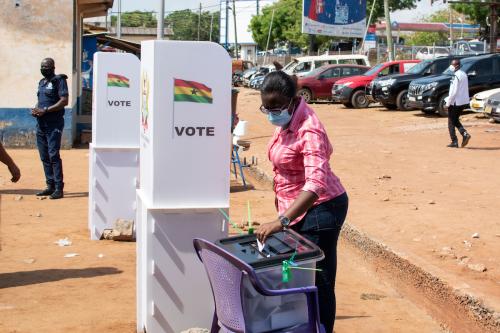This viewpoint is part of Foresight Africa 2024.
The public procurement system is the framework of laws, institutions, and practices relied on by the public sector to obtain the goods, services, and construction needed to function and maximize public welfare. It makes up a significant proportion of gross domestic product (GDP) and public expenditure. The magnitude of resources involved in public procurement underscores its potential as a vehicle to promote government policies covering the spectrum of sustainability issues, encompassing the social, economic, and environmental domains.
An emerging facet within public procurement is gender-responsive procurement. This has been described by the Organisation of Economic Development and Cooperation (OECD) as “the introduction of gender requirements and considerations into public procurement policies and practices, in order to use public procurement as an instrument to advance gender equality.” The objective of gender-responsive procurement is to utilize procurement as a catalyst to advance gender equality and women’s economic empowerment. This is important given the correlation between women’s economic empowerment and the achievement of the Sustainable Development Goals (SDGs). There is a link between the full integration of women into economic activities, domestic competitiveness, and economic growth. Women’s economic empowerment has further implications for social issues such as child health, education, poverty, and the amelioration of gender-based violence. Social resilience is enhanced through women’s economic empowerment, as is the ability of economies to recover from natural and man-made disasters. Gender-responsive procurement is thus important in that it has far-reaching global socioeconomic implications.
Advancing gender equality through public procurement can take three main forms: increasing the participation of women-owned businesses in public procurement, such as through set-asides for women; increasing the participation of gender-responsive businesses in public procurement, such as through price preferences for such businesses; and ensuring that public services are designed to consider their impact on women by ensuring that public services meet the specific and gendered needs of women.
These low numbers may be attributed to barriers affecting women entrepreneurs. These include structural impediments intrinsic to the procurement system, such as demand aggregation requirements, competing priorities in procurement, and the complexity of the procurement process. Policy-related and sociocultural impediments also serve as obstacles to women seeking access to procurement opportunities. These include the gender bias displayed by procurement officials and financial institutions, an entrepreneurship gap between male and female entrepreneurs, disparities in sectors where women-owned businesses predominate (which do not always align with public contract opportunities), and the limited integration of gender equality and public procurement policies. These are exacerbated by entrenched societal norms that perpetuate discriminatory inheritance practices (limiting women’s access to productive assets) as well as household dynamics that subordinate women’s business expansion desires to their partners and household needs. Corruption has also been revealed as a barrier to women accessing procurement opportunities, mainly because women often are not part of existing corruption networks, may be less willing to engage in financially risky behaviour, and are often victims of sexual extortion in the procurement space.
Governments must adopt a comprehensive approach to gender-responsive procurement focusing on the legal and policy framework and the structural, operational, financial, and social issues that are obstacles to women.
To address these barriers, governments must adopt a comprehensive approach to gender-responsive procurement focusing on the legal and policy framework and the structural, operational, financial, and social issues that are obstacles to women. It is thus recommended that governments prioritize the following:
- Pass adequate legislation and regulations on gender-responsive procurement, which include set-asides/preferences for women-owned businesses.
- Create synergies between gender equality, public procurement, and women’s economic empowerment frameworks with measurable targets.
- Address the access to finance issues faced by women-owned businesses.
- Prioritize the collation and publication of gender disaggregated data in public procurement.
- Simplify the procurement process by removing bid and performance guarantees in procurements targeting women-owned businesses.
- Engage in capacity building and advocacy programs on gender-responsive requirements.







Commentary
Promoting gender equality in Africa through gender-responsive procurement
July 23, 2024